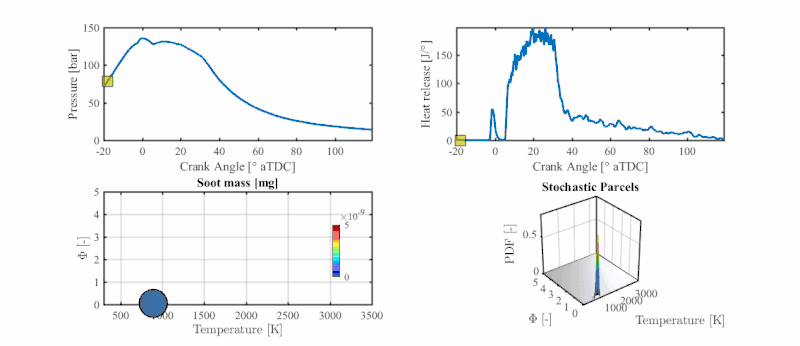 | |
| Developer(s) | CMCL Innovations[1] |
|---|---|
| Stable release | 2021.2
/ (1 September 2021) |
| Operating system | Microsoft Windows |
| Type | Engineering Software |
| License | Proprietary software |
| Website | www |
The SRM Engine Suite is an engineering software tool used for simulating fuels, combustion and exhaust gas emissions in internal combustion engine (IC engine) applications. It is used worldwide by leading IC engine development organisations and fuel companies. The software is developed, maintained and supported by CMCL Innovations,[1] Cambridge, U.K.
Applications
The software has been applied to simulate almost all engine applications and all transportation fuel combinations with many examples[2] published in numerous leading peer-reviewed journals, a brief summary of these articles is presented here.[3]
- Spark ignition combustion mode: Sub-models to simulate Direct Injection Spark Ignition engines for regular flame propagation events,[4] PM[5] and NOx[4] exhaust gas emissions. Further analysis of knocking [6] and irregular combustion events [7] are facilitated through the implementation of user-defined or the chemical kinetic fuel models included with the tool.
- CIDI (diesel) combustion mode: Sub-models for direct injection, turbulence and chemical kinetic enable the simulation of diesel combustion and emission analysis. Typical user projects have included combustion, PM and NOx simulation over a load-speed map,[8] virtual engine optimization,[9] comparison with 3D-CFD[8] and injection strategy optimization.[10]
- Low temperature combustion mode: Known as HCCI or premixed CIDI combustion (PCCI, PPCI), ignition and flame propagation in low temperature combustion mode is more sensitive to fuel chemistry effects. By accounting for user defined or by applying the default chemical kinetic fuel models, users do benefit from enhanced predictive performance. Typical projects include identifying the operating [11] and misfire limits [12] for multiple fuel types.
- Advanced fuels: To date the model has been applied to conventional diesel,[8][9] gasoline,[4][5] blends of gasoline and diesel,[12] bio-fuels,[13] hydrogen, [14] natural gas, [15] and ethanol-blended gasoline fuel [16] applications.
- Exhaust gas emissions: Through the implementation of detailed chemical kinetic in both the gas [8] and solid particulate[5] phases, all conventional automotive and non-road exhaust gas emissions are simulated in detail.

The model
The software is based on the stochastic reactor model (SRM),[17] which is stated in terms of a weighted stochastic particle ensemble. SRM is particular useful in the context of engine modelling [18] as the dynamics of the particle ensemble includes detailed chemical kinetics whilst accounting for inhomogeneity in composition and temperature space arising from on-going fuel injection, heat transfer and turbulence mixing events. Through this coupling, heat release profiles and in particular the associated exhaust gas emissions (Particulates, NOx, Carbon monoxide, Unburned hydrocarbon etc.) can be predicted more accurately than if using the more conventional approaches of standard homogenous and multi-zone reactor methods.[3]
Coupling with third party software tools
The software can be coupled as a plug-in into 1D engine cycle software tools,[3] are capable of simulating the combustion and emissions during closed volume period of the cycle (combustion, TDC and negative valve overlap).
An advanced Application programming interface enables for the model to be coupled with a user-defined codes such as 3D-CFD [19] or control [14] software.
See also
References
- 1 2 "Advanced software, consulting and training for the powertrain, energy and process engineering industries". CMCL Innovations. 12 January 2013. Retrieved 26 March 2013.
- ↑ "User Stories | CMCL Innovations". www.cmclinnovations.com. Retrieved 14 February 2017.
- 1 2 3 Coble; et al. (2011). "Implementing Detailed Chemistry and In-Cylinder Stratification into 0/1-D IC Engine Cycle Simulation Tools". SAE Technical Paper. SAE Technical Paper Series. 1. doi:10.4271/2011-01-0849. SAE 2011-01-0849.
- 1 2 3 Etheridge; et al. (2011). "Modelling cycle to cycle variations in an SI engine with detailed chemical kinetics". Combustion and Flame. 158: 179–188. doi:10.1016/j.combustflame.2010.08.006.
- 1 2 3 Etheridge; et al. (2011). "Modelling soot formation in a DISI engine". Proceedings of the Combustion Institute. 33 (2): 3159–3167. doi:10.1016/j.proci.2010.07.039.
- ↑ "The impact of fuel properties on "knocking" combustion in boosted spark ignition engines" (PDF). CMCL Innovations. 2012. Retrieved 14 February 2017.
- ↑ "Predictive combustion simulations for "downsized" direct injection spark-ignition engines" (PDF). CMCL Innovations. 2010. Retrieved 14 February 2017.
- 1 2 3 4 Smallbone; et al. (2013). "Virtual Performance and Emissions Mapping for Diesel Engine Design Optimization". SAE Technical Paper. SAE Technical Paper Series. 1. doi:10.4271/2013-01-0308. SAE 2013-01-0308.
- 1 2 Smallbone; et al. (2011). "Identifying Optimal Operating Points in Terms of Engineering Constraints and Regulated Emissions in Modern Diesel Engines". SAE Technical Paper. SAE Technical Paper Series. 1. doi:10.4271/2011-01-1388. SAE 2013-01-0308.
- ↑ "Partially-Premixed Compression Ignition (PPCI) and Low Temperature Combustion (LTC) modes". CMCL Innovations. 2010. Archived from the original on 28 February 2014.
- ↑ Bhave; et al. (2005). "Evaluating the EGR-AFR Operating Range of a HCCI Engine". SAE Technical Paper. SAE Technical Paper Series. 1. doi:10.4271/2005-01-0161. SAE 2005-01-0161.
- 1 2 Smallbone; et al. (2011). "Simulating PM Emissions and Combustion Stability in Gasoline/Diesel Fuelled Engines". SAE Technical Paper. SAE Technical Paper Series. 1. doi:10.4271/2011-01-1184. SAE 2011-01-1184.
- ↑ Mosbach; et al. (2006). "Simulating a Homogeneous Charge Compression Ignition Engine Fuelled with a DEE/EtOH Blend". SAE Technical Paper. SAE Technical Paper Series. 1. doi:10.4271/2006-01-1362. SAE 2006-01-1362.
- 1 2 Aldawood; et al. (2009). "HCCI Combustion Phasing Transient Control by Hydrogen-Rich Gas: Investigation Using a Fast Detailed-Chemistry Full-Cycle Model". SAE Technical Paper. SAE Technical Paper Series. 1. doi:10.4271/2009-01-1134. SAE 2009-01-1134.
- ↑ Bhave; et al. (2004). "Analysis of a natural gas fuelled homogeneous charge compression ignition engine with exhaust gas recirculation using a stochastic reactor model". International Journal of Engine Research. 5: 93–104. doi:10.1243/146808704772914273. S2CID 93782071.
- ↑ Jiawei; et al. (2021). "Effects of Ethanol-Blended Fuel on Combustion Characteristics, Gaseous and Particulate Emissions in Gasoline Direct Injection (GDI) Engines". SAE Technical Paper. SAE Technical Paper Series. 1. doi:10.4271/2021-26-0356. S2CID 244187125. SAE 2021-26-0356.
- ↑ Kraft, Markus (1998). Stochastic Modeling of Turbulent Reacting Flow in Chemical Engineering (Fortschritt-Berichte, 391 ed.). VDI-Verlag. ISBN 978-3-18-339106-6.
- ↑ Kraft, M; Maigaard, P; Mauss, F; Christensen, M; Johansson, B (2000). "Investigation of combustion emissions in a homogeneous charge compression injection engine: Measurements and a new computational model". Proceedings of the Combustion Institute. 28 (1): 1195–1201. doi:10.1016/S0082-0784(00)80330-6.
- ↑ Cao; et al. (2009). "Influence of Injection Timing and Piston Bowl Geometry on PCCI Combustion and Emissions". SAE Technical Paper. 2: 1019–1033. doi:10.4271/2009-01-1102. SAE 2009-01-1102.